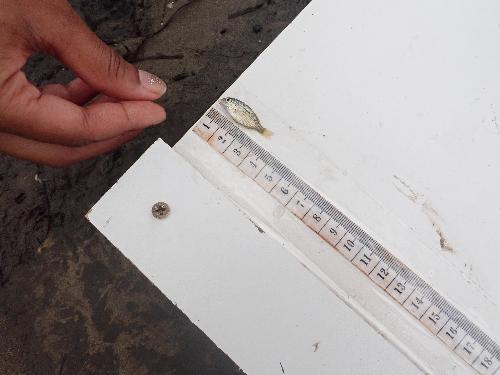Merrisa Naidoo
(1) Identify the sources of plastics in seagrass habitats in the Knysna estuary,
(2) Assess the possibility of eelgrass habitats acting as sinks for microplastic accumulation,
(3) Assess the occurrence of microplastic ingestion in wild pipefish and wild fish larvae
(4) Determine if a novel, non-destructive gut flushing protocol could be viable for assessing microplastic ingestion in syngnathids
(5) Gauge through short term surveys the willingness of local community members to change their waste disposal behaviour by using the idea of syngnathids being affected by plastic contamination as a catalyst and education tool

Seine netting for Juvenile Fish in the Knysna Estuary © Carolin Wilhelm
Assessing the impacts of plastic pollution in estuaries is integral in determining the significance of terrestrial inputs to oceanic environments (Naidoo et al. 2015).

Measuring the total length of specimens collected ©Carolin Wilhelm
South Africa is currently ranked 11th among the top 20 countries for its highly mismanaged plastic debris (Jambeck et al. 2015). Plastic pollution has been found to pose severe threats to marine organisms (Fieber, 2017). However, little is known about the potential impact from microplastics on syngnathids and larval fish let alone estuarine systems. This paucity of information is concerning, considering South Africa boasts 255 functional estuaries along its coastline (Lamberth and Turpie, 2003). As a matter of fact, the Knysna estuary is among the most heavily used water bodies in South Africa due to urban sprawl and associated industrial, domestic and recreational activities. However, the currently alarming threat of plastic pollution has not been established or investigated within the bounds of what happens to be one of the most important estuarine systems in South Africa.
The Knysna estuarine system accounts for an estimated 42 % of South Africa’s estuarine biodiversity and contains the largest eelgrass beds (Turpie et al. 2002). It is regarded as the stronghold for Zostera capensis which fulfils the roles of an ecosystem engineer and keystone species. Globally, seagrass habitats are among the most productive and valuable ecosystems on earth, ranging from their invaluable roles in sediment stabilization, erosion, water flow management, nutrient trapping and providing a viable habitat and nursery ground for fish and invertebrates (Constanza et al. 2014). However, Z.capensis currently faces continual decline due to coastal development and habitat destruction and is thus listed as vulnerable in the IUCN Red Data List of Species (IUCN, 2010). The endangered Knysna seahorse (Hippocampus capensis) (IUCN, 2013) and juvenile fish stocks which have important economic and ecological value rely on the resilience of Z.capensis. This study will assess the environmental interactions between microplastics, syngnathids and fish larvae.